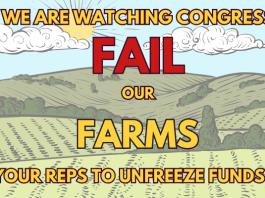Tom Jefferson (who asked that we not use his real name) has been farming beef in Maryland for over 50 years. But because of the State’s Revised Nutrient Management Law, he and his son may be forced to give up cattle and begin raising row crops. At issue are changes to the state’s regulations tied to existing laws about nutrient management plans. The new regulations respond in part to recent recommendations by the Environmental Protection Agency (EPA) regarding Total Maximum Daily Loads of pollutant (TMDLs). The end result of good water quality intentions may be declining stream health, increased soil erosion, and a decrease in farmers making a living raising beef.
As Mr. Jefferson explains, ”Maryland came up with this setback from all stream banks that you can have no organic fertilizer, a fancy name for cow shit, within ten feet of the stream banks.” Making his point for him is a fact sheet on Maryland’s Revised Nutrient Management Regulations that explains that a 10 to 35 foot “no fertilizer zone” must be used along surface waters and streams. Says Jefferson, “Under the present regulations, they do not say that they must be fenced out, but that is the only thing you can do. So we’ll practically have to fence all of our streams and put in stream crossings to get our cattle across them anywhere. And in some cases we’ll end up with parcels that are fenced up and have no water in them and we’ll have to put in [water]. In some cases you’d have to fence in flood plains. And that will get washed out.”
If Jefferson has to come into compliance with these regulations, the preliminary estimates for fencing are $55,000 and building stream crossings will cost another $25,000. This does not include adding new water sources. Farmers can get cost share assistance from the USDA Natural Resources Conservation Service. But, as he points out, “If you get a cost share, you’ll have to meet NRCS standards.” NRCS requires that installed fences be maintained for up to 10 years, and maintenance costs for fences affected by annual flooding in the areas where he would need fences are discouraging.
The final rub is that fencing along his meandering streams will result in a loss of 15 acres of pasture from his total of 200 acres of pasture. Between the fencing expenses and the loss of land, Jefferson figures it won’t be profitable to try to continue grazing.
While these decisions have the potential to severely impact farmers, the basis for them is not clear. “Their scientific backing is very questionable.” says Jefferson.
He has a point. While Total Maximum Daily Loads are one important measure of healthy streams and stream banks, scientist point out that they aren’t the only measure. In his 2007 study “Managed grazing in stream corridors” Dr. Howard Moechnig found that there are significant positive environmental changes in streams when livestock grazing is converted from continuous to rotational management. He notes that the composition, health and vigor of the streambank plant community benefits from grazing, and that streambanks are stabilized and the stream channel is improved.
A 2005 scientific review of research on livestock grazing stream banks by Dr. Carmen Agourdis found that all streams do not respond the same to changes in management. Livestock exclusion might help in some situations, but normal stream bank erosion and channelization can cause huge sediment loads that cancel out any benefits from changes in management.
The real issue is the hydrology of the stream, the stream banks in question, and overall grazing management. Steep stream banks or banks with sand or gravelly soil are highly erodible. Gently sloping banks with strong vegetative cover, however, may not be easily reached with mowing equipment and would benefit from controlled grazing.
Dr. James Russell from Iowa State has been looking into the effects of grazing livestock along streams. In some of his recent work, he found that, indeed, cattle with unrestricted access to stream banks can cause erosion and bank destabilization. But careful management of grazing cattle in riparian areas doesn’t increase stream bank erosion.
Farmer Jefferson heard Dr. Russell speak a few years ago, and he agrees. He says “there was more natural erosion than [there was] from the cattle. And that’s what we’ve found at home, not scientifically documented.”
Without grazing, plant communities along streambanks can convert to brush and other woody growth. The grasses that had previously cloaked gently sloping banks are shaded out. Over time, stream banks become steeper, and the stream channel grows wider and shallower. Water quality is impaired as sediment from the banks erodes into the stream.
Many farmers understand this and argue vehemently against excluding their livestock. They understand that careful grazing management on stream banks protects the banks, but that overgrazing banks leads to devastating results, and they act accordingly.
“The way the Maryland regs are set, one shoe size fits all for the whole state,” says Jefferson. “[The regulations are being applied] from the Eastern Shore which is perfectly flat to the mountains of western Maryland and everything in between. They write it generally, and then apply the regulations afterwards. We’re kind of the guinea pigs, I’m afraid.”
Adding to his frustration is that Jefferson hasn’t gotten a clear answer about what he’ll be expected to do if he’d like to continue raising and grazing cattle. “The regulations leave a little bit of a loophole in there as determined by NRCS. But you don’t know who is going to be making the recommendations and it may change from one [person] to another….you don’t know what you are up against. The sure thing is you have to keep animals out. They say ‘we’ll leave it up to the technicians to decide’. There’s nothing you can count on. The only thing you can do is, you got to plan on fencing.”
What is sure is that decisions are being made or considered that have the potential to severely impact farmers. Every few years in Vermont, the state legislature considers laws to exclude all livestock from streams and waterways. Reports, and fact sheets, like this one from Ohio State Extension outline the detrimental effects of livestock grazing without discussing the benefits or the effects of regulation on farming and ranching.
So what’s a producer to do? We’ll discuss threats and options for change in upcoming articles in this series. We’ll also describe how some regions are approaching this issue in partnership with farmers and ranchers by paying them for practices that protect and improve watersheds. If you have something to share, or something you’d like us to look into, contact us and we’ll include it in the series.




Sorry to hear about the new regulatory issues and their effect on livestock producers in Maryland. In Texas we do not have those kind of strict rules (yet) but times are changing. I clearly remember about 20 years ago at a water quality conference that the EPA and other regulatory agencies told landowners that if they did not voluntarily adopt good water quality practices that they would eventually be regulated. I think that was fair warning;
Slowly but surely, ranchers here are paying more and more attention to the way they graze their riparian areas. We still have a long way to go, but many ranchers are now giving preferential treatment to their creek areas. Some have voluntarily chosen to withold grazing on their creeks for several years to jump start the growth of the necessary vegetation; others are using specialized rotations, flash grazing or whatever you want to call it to maintain good dense riparian vegetation.
Good dense creek bottom vegetation is one of the very best water quality practices – it dissipates the energy of floodwater, reduces erosion, slows down the water, traps sediment and helps to recharge the shallow aquifers. Its the responsible thing to do and it can be a win win for ranchers and the public.
Nothing can make livestock producers look worse than overgrazed creek bottom pastures and nothing can make them look better than maintaining well managed, dense riparian vegetation.
I am retired NRCS (35 years) and worked a lot with riparian management in the last 10 years. I know things are different in other states, but I would suggest that instead of griping about over-regulation, instead try to do common sense things voluntarily to reduce the need for regulation.
I noted that the Maryland Nutrient Management Regs had some common sense flexibility for grazing – they did not insist only on excluding animals from the creek. Hope that some reasonable solutions can be found by working together.
Here’s an example of how proper grazing can enhance streams. It was posted a Linked-in discussion group by Dr. Roy Roath, Professor Emeritus at Colorado State Univiersity.
David Jessup, Sylvan Dale Ranch.
In a program implemented north of Fort Collins in a ‘short grass prairie” receiving an average of 10-12 inches of annual precipitation; we implemented a grazing program designed explicitly to greatly increase water capture and retention. This requires a designed rotational grazing program to allow use, foster tillering and plant recruitment and management for growth and regrowth to full recovery in every pasture every year. In doing this we were able to increase forage on offer, leave greater residual cover and increase the diversity of the stand including greatly increasing the forb component. What we found is that the “short grass prairie” was really a mixed grass prairie suppressed by years of inappropriate grazing. We soon had major increases in cool season grasses and forbs and many tall warm season grasses that were not evident and not even thought to be a part of this ecosystem when we started. After five years in this program we had two dry streambeds that became streams that flowed 365 days a year and began to grow riparian vegetation the full length of their corridor. A critical part of this management strategy is to regain and manage cover on the primary terraces bordering the streambed. These are water storage areas and must have structure and cover to maintain the integrity to the stored water in the system. I can’t say that this works everywhere but I have enough experience in a variety of environments to know that one can vastly improve water capture and in doing so has a great probability of good things happening.
David,
Very interesting; almost sounds like one of those “too good to be true” things. Can you provide more details on the grazing program that produced these results or a link to research or other info that has some specifics. In the midst of this drought, we all need some good and encouraging news. Thanks
Here’s contact information for Roy Roath. He can supply the info you request. Roy Roath is Extension Range Specialist at CSU.
royr@cnr.colostate.edu
Comments are closed.